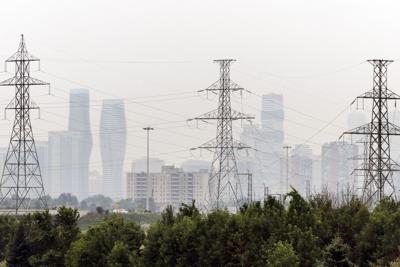As wildfires in northern Ontario push ÎÚÑ»´«Ã½’s air quality to among the worst in the world, experts warn young children are especially at risk of smoke exposure.
Aside from being more vulnerable to the immediate health effects of smoke inhalation, new research suggests repeated exposure to air pollution could have long-term ramifications for their development.
Environmental health experts urge parents to keep their kids indoors when possible in these smoky conditions. But while a mask might help limit their exposure, they aren’t necessary for most kids.
With the city once again blanketed in wildfire smoke, experts are warning that long-term exposure to air pollution can lead to higher risk of …
With the city once again blanketed in wildfire smoke, experts are warning that long-term exposure to air pollution can lead to higher risk of …
Here’s why.
Why are kids more vulnerable to wildfire smoke?
It mainly has to do with their small bodies, explained Dr. Samantha Green, a family physician with Unity Health ÎÚÑ»´«Ã½.
Given their size, young children inhale more air per kilogram of body mass, meaning more airborne pollutants in proportion to their bodies. And because their lungs are still developing, the organ is more susceptible to damage.
That means the younger one is, the more they may be affected. “Babies and the youngest children are most at risk,” Green explained.
In the short term, kids might experience similar symptoms to adults, just more intense, Green said. Think chest tightness, trouble breathing, sore throat, coughing, burning eyes or dizziness.
“In children who have asthma, or allergies, or other chronic health conditions, they may experience worsening in their underlying (conditions),” Green continued.
The scarfs were issued after veteran firefighters won a battle to get presumptive illness coverage due to chronic smoke exposure.
The scarfs were issued after veteran firefighters won a battle to get presumptive illness coverage due to chronic smoke exposure.
But in the long run, emerging research suggests repeated exposure could potentially lead to decreased overall lung function, an increased risk of lung and brain tumours, and potential impact on developmental outcomes, according to Green.
“The greater time spent experiencing the poor air quality and the more repeated exposures, the worse the risk,” she continued.
Should kids mask up in smoky conditions?
The answer is “not really,” according to Jeffrey Brook, an associate professor at the University of ÎÚÑ»´«Ã½â€™s Dalla Lana School of Public Health.
It’s true that N95 masks can help catch some of the harmful particles released in wildfire smoke, but given the time-limited nature of this event, Brook and other experts say they aren’t necessary.
“We don’t want people to panic,” he said. “The level that we’re seeing here are what children are dealing with day in and day out in other countries in the world … It makes sense to be prudent, but not to panic.”
Green added that while masks might catch particulate matter, they won’t keep us safe from the other dangerous chemicals in smoke, such as carbon monoxide, ammonia, ozone and nitrogen dioxide.
Environment Canada urges residents to limit their time outdoors. But even when inside, most buildings can only reduce airborne pollutants by half.
Environment Canada urges residents to limit their time outdoors. But even when inside, most buildings can only reduce airborne pollutants by half.
“In children, N95 masks often don’t fit properly, often aren’t worn properly and really are not a solution,” Green said.
“I think for a child with underlying asthma, who must be outside, I would recommend wearing an N95 mask. But really, as much as possible, we should be keeping all children inside.”
How to protect kids from wildfire smoke
The best solution, according to experts, is to keep your kids indoors when it’s smoky out.
On Monday, ÎÚÑ»´«Ã½’s air quality health index hit the very top of the scale at 10+, or “very high risk.” Parents should consider rescheduling outdoor activities at any level higher than a seven, according to Helen Doyle, chair of the co-ordinating committee at the Canadian Partnership for Children’s Health and Environment.
Experts previously told the Star most buildings can only keep out about half of all air pollutants, but it’s better than having kids outside without protection.
Otherwise, Doyle advises parents to keep an eye on the air quality health index, and check for any updates as they come. She notes that  are able to alert you once the index reaches a certain level.
If possible, keep your windows closed and the air-conditioning on if you have the option. Doyle says you can also consider purchasing a portable air filter, or making your own.
The Star previously outlined how to make an affordable filter using a fan, air filters, duct tape and cardboard.
“We can only adapt so much and this is such a good example of where adaptation is not ideal,” Green said. “We need to keep children indoors during the summer and we need to refrain from everyday childhood activities like going swimming in Lake Ontario or playing on a playground.”
The fact we’re being pushed to do so is “key evidence of the climate crisis, and unfortunately, things will continue to get worse year over year from here on in unless we stop burning fossil fuels,” Green finished.






























To join the conversation set a first and last name in your user profile.
Sign in or register for free to join the Conversation